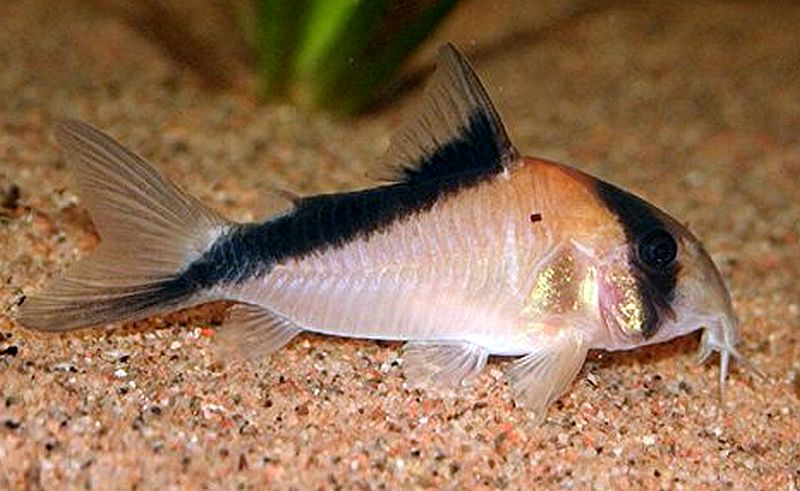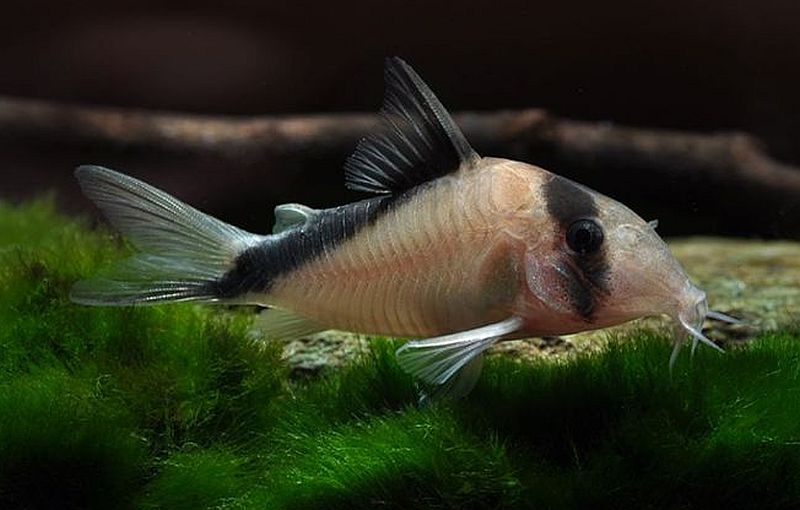The Sand’s Cory (Corydoras davidsandsi) is endemic to the lower rio Negro in Brazil where it primarily inhabits tannin stained flooded forests, creeks, and “whitewater areas” with little detectable water hardness, an acidic pH, and very low conductivity.
The Sand’s Cory is a facultative air breather that possess a modified intestine that has evolved to facilitate the breathing of atmospheric oxygen. This allow the fish to survive in oxygen depleted environments where other species would perish and is why they will occasionally rise to the surface in your aquarium to gulp in air.
Like other Corydoras they have stiffened pectoral fin spines that are capable of piercing the skin and causing a painful sting. Secretions from the axillary glands at the base of the spines are venomous and mildly toxic, so care should be exercised when handling them.
The Sand’s Cory is similar to Corydoras melini in looks. Both fish are tan and have a black stripe that runs from the lower dorsal fin to the lower caudal fin, just past the caudal peduncle. However, when viewed from above, the black line splits above the caudal peduncle in the Sand’s Cory and in most other Cory species, it does not.
Additionally, it can be distinguished from Corydoras melini by it’s having a pale orange area between the dark facial stripe and the dorsal bars, and by lacking additional dark markings on it’s flanks. Aside from the vertical eye stripe and the aforementioned back stripe, the flanks of C. davidsandsi are without further pigmentation.
Female Sand’s Corys are longer and plumper when viewed from above, especially during spawning.
The Sand’s Cory is a peaceful, gregarious species that should be housed with at least 4 to 6 of their own kind. They are best kept in at a densely planted aquarium of at least 20 gallons or larger, with a sand or fine gravel substrate, some driftwood and rocks to provide cover, and a good filtration system that provides a small amount of current. These fish require clean water and low nitrites to remain disease free.
The Sand’s Cory has been bred in an aquarium environment. Two males per female should be placed in a breeding tank furnished with a sandy substrate, some plants and driftwood. When the female is visibly full of eggs, perform a 50 to 70% water change and place a small power filter or powerhead into the tank to increase oxygenation and water flow. Repeat the water changes daily until the fish spawn.
The eggs are normally laid on the driftwood, among the plants, on spawning mops, and occasionally on the sides of the tank glass. After spawning, either the parents or the eggs should be removed from the spawning tank.
If the eggs are removed, place them in the same well oxygenated water as the spawning tank and add a few drops of Methylene Blue or some Indian Almond Leaves
to prevent fungus from developing.
In 3 to 4 days the eggs will hatch and the fry will be free swimming in another 3 days or so. Feed the fry microworms or newly hatched brine shrimp until they are able to eat crushed flake food.
In their natural habitat, Sand’s Corys are omnivores that forage along the bottom for small insects, worms, crustaceans, and plant matter. In an aquarium environment, they will accept most sinking dried foods, as well as live, frozen, and freeze dried bloodworms, Tubifex, blackworms, brine shrimp, etc.
They should not be expected “clean” the bottom and survive on any foods “left over” from other inhabitants of the aquarium. A well balanced diet is essential to their well being.
The Sand’s Cory is a relatively new addition to the tropical fish keeping hobby and is occasionally available online or from specialty fish shops. They are often imported with mixed shipments, and when available for purchase are usually 3/4″ to 1-1/4″ long.
Minimum Tank Size: 20 gallons
Temperament: Peaceful
Aquarium Hardiness: Hardy
Water Conditions: 68-77° F, KH 2-12, pH 6.2-7.2
Max. Size: 2½”
Color Form: Black, White
Diet: Omnivore
Compatibility: Great in community tanks
Origin: Brazil
Family: Callichthyidae
Lifespan: 6 Years or more
Aquarist Experience Level: Beginner to Intermediate




